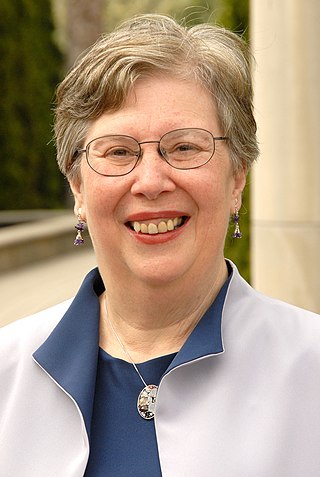Related Research Articles
The Protein Data Bank (PDB) is a database for the three-dimensional structural data of large biological molecules, such as proteins and nucleic acids. The data, typically obtained by X-ray crystallography, NMR spectroscopy, or, increasingly, cryo-electron microscopy, and submitted by biologists and biochemists from around the world, are freely accessible on the Internet via the websites of its member organisations. The PDB is overseen by an organization called the Worldwide Protein Data Bank, wwPDB.

The Structural Classification of Proteins (SCOP) database is a largely manual classification of protein structural domains based on similarities of their structures and amino acid sequences. A motivation for this classification is to determine the evolutionary relationship between proteins. Proteins with the same shapes but having little sequence or functional similarity are placed in different superfamilies, and are assumed to have only a very distant common ancestor. Proteins having the same shape and some similarity of sequence and/or function are placed in "families", and are assumed to have a closer common ancestor.

In biochemistry, a Ramachandran plot, originally developed in 1963 by G. N. Ramachandran, C. Ramakrishnan, and V. Sasisekharan, is a way to visualize energetically allowed regions for backbone dihedral angles ψ against φ of amino acid residues in protein structure. The figure on the left illustrates the definition of the φ and ψ backbone dihedral angles. The ω angle at the peptide bond is normally 180°, since the partial-double-bond character keeps the peptide bond planar. The figure in the top right shows the allowed φ,ψ backbone conformational regions from the Ramachandran et al. 1963 and 1968 hard-sphere calculations: full radius in solid outline, reduced radius in dashed, and relaxed tau (N-Cα-C) angle in dotted lines. Because dihedral angle values are circular and 0° is the same as 360°, the edges of the Ramachandran plot "wrap" right-to-left and bottom-to-top. For instance, the small strip of allowed values along the lower-left edge of the plot are a continuation of the large, extended-chain region at upper left.

UniProt is a freely accessible database of protein sequence and functional information, many entries being derived from genome sequencing projects. It contains a large amount of information about the biological function of proteins derived from the research literature. It is maintained by the UniProt consortium, which consists of several European bioinformatics organisations and a foundation from Washington, DC, United States.
The European Bioinformatics Institute (EMBL-EBI) is an intergovernmental organization (IGO) which, as part of the European Molecular Biology Laboratory (EMBL) family, focuses on research and services in bioinformatics. It is located on the Wellcome Genome Campus in Hinxton near Cambridge, and employs over 600 full-time equivalent (FTE) staff. Institute leaders such as Rolf Apweiler, Alex Bateman, Ewan Birney, and Guy Cochrane, an adviser on the National Genomics Data Center Scientific Advisory Board, serve as part of the international research network of the BIG Data Center at the Beijing Institute of Genomics.

Sir Thomas Leon Blundell, is a British biochemist, structural biologist, and science administrator. He was a member of the team of Dorothy Hodgkin that solved in 1969 the first structure of a protein hormone, insulin. Blundell has made contributions to the structural biology of polypeptide hormones, growth factors, receptor activation, signal transduction, and DNA double-strand break repair, subjects important in cancer, tuberculosis, and familial diseases. He has developed software for protein modelling and understanding the effects of mutations on protein function, leading to new approaches to structure-guided and Fragment-based lead discovery. In 1999 he co-founded the oncology company Astex Therapeutics, which has moved ten drugs into clinical trials. Blundell has played central roles in restructuring British research councils and, as President of the UK Science Council, in developing professionalism in the practice of science.
Crystallographic Information File (CIF) is a standard text file format for representing crystallographic information, promulgated by the International Union of Crystallography (IUCr). CIF was developed by the IUCr Working Party on Crystallographic Information in an effort sponsored by the IUCr Commission on Crystallographic Data and the IUCr Commission on Journals. The file format was initially published by Hall, Allen, and Brown and has since been revised, most recently versions 1.1 and 2.0. Full specifications for the format are available at the IUCr website. Many computer programs for molecular viewing are compatible with this format, including Jmol.
The Worldwide Protein Data Bank, wwPDB, is an organization that maintains the archive of macromolecular structure. Its mission is to maintain a single Protein Data Bank Archive of macromolecular structural data that is freely and publicly available to the global community.
The EM Data Bank or Electron Microscopy Data Bank (EMDB) collects 3D EM maps and associated experimental data determined using electron microscopy of biological specimens. It was established in 2002 at the MSD/PDBe group of the European Bioinformatics Institute (EBI), where the European site of the EMDataBank.org consortium is located. As of 2015, the resource contained over 2,600 entries with a mean resolution of 15Å.

Helen Miriam Berman is a Board of Governors Professor of Chemistry and Chemical Biology at Rutgers University and a former director of the RCSB Protein Data Bank. A structural biologist, her work includes structural analysis of protein-nucleic acid complexes, and the role of water in molecular interactions. She is also the founder and director of the Nucleic Acid Database, and led the Protein Structure Initiative Structural Genomics Knowledgebase.
SUPERFAMILY is a database and search platform of structural and functional annotation for all proteins and genomes. It classifies amino acid sequences into known structural domains, especially into SCOP superfamilies. Domains are functional, structural, and evolutionary units that form proteins. Domains of common Ancestry are grouped into superfamilies. The domains and domain superfamilies are defined and described in SCOP. Superfamilies are groups of proteins which have structural evidence to support a common evolutionary ancestor but may not have detectable sequence homology.

The Protein Common Interface Database (ProtCID) is a database of similar protein-protein interfaces in crystal structures of homologous proteins.

WeNMR is a worldwide e-Infrastructure for NMR spectroscopy and structural biology. It is the largest virtual Organization in the life sciences and is supported by EGI.

Macromolecular structure validation is the process of evaluating reliability for 3-dimensional atomic models of large biological molecules such as proteins and nucleic acids. These models, which provide 3D coordinates for each atom in the molecule, come from structural biology experiments such as x-ray crystallography or nuclear magnetic resonance (NMR). The validation has three aspects: 1) checking on the validity of the thousands to millions of measurements in the experiment; 2) checking how consistent the atomic model is with those experimental data; and 3) checking consistency of the model with known physical and chemical properties.
Michael Joseph Ezra Sternberg is a professor at Imperial College London, where he is director of the Centre for Integrative Systems Biology and Bioinformatics and Head of the Structural bioinformatics Group.

Randy John Read is a Wellcome Trust Principal Research Fellow and professor of protein crystallography at the University of Cambridge.

Jill Trewhella FAAAS FLANL Dist FRSN is a biophysicist who has worked in both Australia and the United States.

Sarah Amalia Teichmann is a German scientist who is head of cellular genetics at the Wellcome Sanger Institute and a visiting research group leader at the European Bioinformatics Institute (EMBL-EBI). She serves as director of research in the Cavendish Laboratory, at the University of Cambridge and a senior research fellow at Churchill College, Cambridge.
Julian John Thurstan Gough is a Group Leader in the Laboratory of Molecular Biology (LMB) of the Medical Research Council (MRC). He was previously a professor of bioinformatics at the University of Bristol.
The Biological Magnetic Resonance Data Bank is an open access repository of nuclear magnetic resonance (NMR) spectroscopic data from peptides, proteins, nucleic acids and other biologically relevant molecules. The database is operated by the University of Wisconsin–Madison and is supported by the National Library of Medicine. The BMRB is part of the Research Collaboratory for Structural Bioinformatics and, since 2006, it is a partner in the Worldwide Protein Data Bank (wwPDB). The repository accepts NMR spectral data from laboratories around the world and, once the data is validated, it is available online at the BMRB website. The database has also an ftp site, where data can be downloaded in the bulk. The BMRB has two mirror sites, one at the Protein Database Japan (PDBj) at Osaka University and one at the Magnetic Resonance Research Center (CERM) at the University of Florence in Italy. The site at Japan accepts and processes data depositions.
References
- ↑ "Looking back on 2016".
- ↑ "Gerard Kleywegt research group page at the EBI". Archived from the original on 2014-10-20.
- ↑ Garwoord, Jeremy (May 2009) "A Guardian of Structural Integrity". Lab Times. pp. 19-23
- ↑ Berman, H. M.; Kleywegt, G. J.; Nakamura, H.; Markley, J. L.; Burley, S. K. (2010). "Safeguarding the integrity of protein archive". Nature. 463 (7280): 425. doi:10.1038/463425c. PMC 4456675 . PMID 20110969.
- ↑ Lewis, T. E.; Sillitoe, I; Andreeva, A; Blundell, T. L.; Buchan, D. W.; Chothia, C; Cozzetto, D; Dana, J. M.; Filippis, I; Gough, J; Jones, D. T.; Kelley, L. A.; Kleywegt, G. J.; Minneci, F; Mistry, J; Murzin, A. G.; Ochoa-Montaño, B; Oates, M. E.; Punta, M; Rackham, O. J.; Stahlhacke, J; Sternberg, M. J.; Velankar, S; Orengo, C (2015). "Genome3D: Exploiting structure to help users understand their sequences". Nucleic Acids Research. 43 (Database issue): D382-6. doi:10.1093/nar/gku973. PMC 4384030 . PMID 25348407.
- ↑ Lewis, T. E.; Sillitoe, I; Andreeva, A; Blundell, T. L.; Buchan, D. W.; Chothia, C; Cuff, A; Dana, J. M.; Filippis, I; Gough, J; Hunter, S; Jones, D. T.; Kelley, L. A.; Kleywegt, G. J.; Minneci, F; Mitchell, A; Murzin, A. G.; Ochoa-Montaño, B; Rackham, O. J.; Smith, J; Sternberg, M. J.; Velankar, S; Yeats, C; Orengo, C (2013). "Genome3D: A UK collaborative project to annotate genomic sequences with predicted 3D structures based on SCOP and CATH domains". Nucleic Acids Research. 41 (Database issue): D499-507. doi:10.1093/nar/gks1266. PMC 3531217 . PMID 23203986.
- ↑ Jones, T. A.; Kleywegt, G. J. (2007). "Experimental Data for Structure Papers". Science. 317 (5835): 194c. doi:10.1126/science.317.5835.194c.
- ↑ Kleywegt, G. J.; Jones, T. A. (1996). "Phi/psi-chology: Ramachandran revisited". Structure. 4 (12): 1395–400. doi: 10.1016/s0969-2126(96)00147-5 . PMID 8994966.
- ↑ Read, R. J.; Adams, P. D.; Arendall Wb, 3rd; Brunger, A. T.; Emsley, P; Joosten, R. P.; Kleywegt, G. J.; Krissinel, E. B.; Lütteke, T; Otwinowski, Z; Perrakis, A; Richardson, J. S.; Sheffler, W. H.; Smith, J. L.; Tickle, I. J.; Vriend, G; Zwart, P. H. (2011). "A new generation of crystallographic validation tools for the protein data bank". Structure. 19 (10): 1395–412. doi:10.1016/j.str.2011.08.006. PMC 3195755 . PMID 22000512.
- ↑ Read, R. J.; Kleywegt, G. J. (2009). "Case-controlled structure validation". Acta Crystallographica Section D. 65 (Pt 2): 140–7. doi:10.1107/S0907444908041085. PMC 2631636 . PMID 19171969.
- ↑ Kleywegt, G. J.; Read, R. J. (1997). "Not your average density". Structure . 5 (12): 1557–69. doi: 10.1016/s0969-2126(97)00305-5 . PMID 9438862.
- ↑ Montelione, G. T.; Nilges, M; Bax, A; Güntert, P; Herrmann, T; Richardson, J. S.; Schwieters, C. D.; Vranken, W. F.; Vuister, G. W.; Wishart, D. S.; Berman, H. M.; Kleywegt, G. J.; Markley, J. L. (2013). "Recommendations of the wwPDB NMR Validation Task Force". Structure. 21 (9): 1563–70. doi:10.1016/j.str.2013.07.021. PMC 3884077 . PMID 24010715.
- ↑ Berman, H. M.; Kleywegt, G. J.; Nakamura, H; Markley, J. L. (2013). "How community has shaped the Protein Data Bank". Structure. 21 (9): 1485–91. doi:10.1016/j.str.2013.07.010. PMC 4435976 . PMID 24010707.
- ↑ Berman, H. M.; Kleywegt, G. J.; Nakamura, H; Markley, J. L. (2013). "The future of the protein data bank". Biopolymers. 99 (3): 218–22. doi:10.1002/bip.22132. PMC 3684242 . PMID 23023942.
- ↑ Berman, H. M.; Kleywegt, G. J.; Nakamura, H; Markley, J. L. (2012). "The Protein Data Bank at 40: Reflecting on the past to prepare for the future". Structure. 20 (3): 391–6. doi:10.1016/j.str.2012.01.010. PMC 3501388 . PMID 22404998.
- ↑ Berman, H. M.; Kleywegt, G. J.; Nakamura, H.; Markley, J. L.; Burley, S. K. (2010). "Safeguarding the integrity of protein archive". Nature. 463 (7280): 425. doi:10.1038/463425c. PMC 4456675 . PMID 20110969.
- ↑ Berman, H. M.; Kleywegt, G. J.; Nakamura, H; Markley, J. L. (2014). "The Protein Data Bank archive as an open data resource". Journal of Computer-Aided Molecular Design. 28 (10): 1009–14. doi:10.1007/s10822-014-9770-y. PMC 4196035 . PMID 25062767.
- ↑ Berman, H. M.; Burley, S. K.; Kleywegt, G. J.; Nakamura, H; Markley, J. L. (2014). "Response to on prompt update of literature references in the Protein Data Bank". Acta Crystallographica Section D. 70 (Pt 10): 2780. doi:10.1107/S1399004714020513. PMC 4984264 . PMID 25286863.